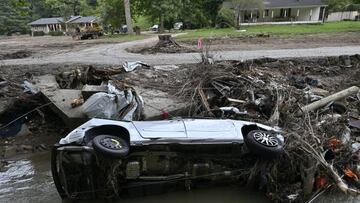What is a mega-flood and could it happen in California?
Some researchers at UCLA are reporting that the California could be in for a historic mega-flood this century?

California is suffering from a historic mega-drought that, that for more than two decades, has inflicted severe consequences for farmers and the agricultural industry more widely. From 2016 to 2018, agricultural commodity sales decreased, only to rise again in 2019 and then fall during the pandemic in 2020.
In addition to drought and excessive heat, wildfires have wreaked havoc throughout the state. Last year, 2,568,948 acres burned across California, about half of what burned in 2020. Already, 185,000 acres have caught fire, a number which is expected to rise significantly thought the fall.
Researchers at the University of California, Los Angeles, are raising awareness of how a flood of biblical proportions could rock the state in the near future.
A megaflood which the researchers call “a sleeping giant,” was described as “an occasional flood so large that it inundates major valleys with water flows hundreds of miles long and tens of miles across.”
The last flood of this size occurred in 1862, and in 2010, a team at UCLA began researching the event, calling “it the ‘ArkStorm scenario.’”
Severe weather expected to increase under a continued high emissions scenario
In April, the researchers released a report that forecasted “increases by 100% in California and 700% in the Pacific Northwest” in the number “of extreme fire weather events being followed by extreme rainfall in this region” by the end of this century. The scorched earth, unable to absorb the excess water brought on by excessive rain, gives into gravity and can have devastating consequences for communities in high-risk zones.
It is a bit hard to believe that these “extreme precipitation events” are on the horizon, given the extreme drought conditions the state continues to face. It is just one example of how climate change alters a multitude of weather events and patterns and, in some cases, exacerbate the damage of each.
The paper also reports the results of various models aiming to demonstrate the impacts of a high emissions scenario where greenhouse gases continue to enter the atmosphere at an ever-growing rate. Under these conditions, “more than 90% of extreme fire weather events in California, Colorado and the Pacific Northwest will be followed within five years by at least three extreme rainfall events, within the same geographic area.”
What is the state doing to decrease the risk of these events?
Those living in the state have long understood the relationship between fire and rain, which can sometimes lead to landslides. One path the state has taken is to work with native tribes whose incenstral knowelge could now help state officials reduce the risk of fire and severe drought. California’s Fourth Climate Change Assessment focused on how the states continued work with tribes to implement these practices.
According to the report, to “revive traditional Native American land management practices,” the US Forest Service is reaching out to and working with tribes to preserve their knowledge outside their communities.
Less of the report focused on how these projects are being completed and how the state is compensating the tribal communities for their collaboration after being ignored for over a century.
“Native Americans in California had long tended the land in ways that preserved watersheds to ease droughts and created barriers to out-of-control fires,” said Rick Flores. Flores currently works at the University of California Santa Cruz Arboretum as a steward of the Amah Mutsun Relearning Program. A leader for the program, Flores, also spoke about some of the mechanisms being carried out to reduce the severity of wildfires, including controlled burns that work to “preserve certain useful plants” as well as “prevent larger fires.”






